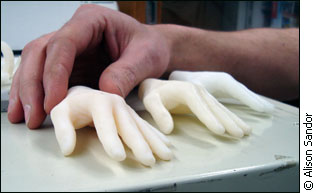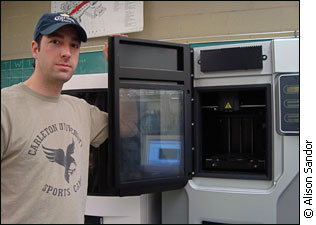But
what is created is anything except ordinary — a human
organ pieced together cell-by-cell by a printer.
These ‘bioprinters’ are a new breed of 3D printers
that have the potential to create a medical breakthrough.
This breakthrough would be printing human organs viable
for transplant.
 |
| Need a hand? 3D printers can accurately
create models based off computer blueprints |
“We want to build a whole organ, like kidney, liver
or heart,” says Vladimir Mironov, an assistant professor
in the Bioprinting Research Center at the Medical University
of South Carolina (MUSC).
Though researchers have used printers to attempt to replicate
organs as early as 2003, Mironov pointed out that the prototypes
printed now are called organ-like tissue construct, because
they are not viable. He says that it will take between
25 and 30 years before organs printed from machines can be
transplanted into humans.
“People build blood vessels and it takes them 10 years. People
build artificial hearts, it took them 25 years,” says
Mironov excitedly in his heavily accented English. “I
don’t know what will happen in the future. I’m
not a technology forecaster. What I can say is if you
give me enough money, enough resources, maybe we can build
this.”
Money and resources are certainly an important factor. Mironov’s
group receives $5 million U.S. from the National Science
Foundation, and $75,000 U.S. from MUSC.
For Mironov, resources also include the printers themselves.
Evolving from 3D to 'bio' printers
The principle behind bioprinters is simple enough, according
to Mark Kata of 360 Technical Services. His company
owns Neatco, which created the two bioprinters for Mironov.
| 'So imagine the pencil
is the syringe, and hand is robotic hand. That’s
the printer. And instead of ink, we have what we
call bioink: cells and tissue. That’s the
principle of machine' |
“The 3D printer sounds really high tech, but it’s
not…It doesn’t matter if you’re dispensing
live cells or ink or glue. You’re just dispensing
it.”
3D printers, such as the two in Carleton University’s
Department of Mechanical and Aerospace Engineering operate
on an X-Y-Z axis, allowing for left to right, back to front
movement.
“Really it’s just a bunch of rods with bearings
and a head moving back and forth,” says Stephan Biljan,
who facilitates the operation of the department’s 3D
printers. “It pretty much works like a glue gun,
where you take your material, heat it up and force it through
a small orifice.”
The printer creates the desired object based on a computer-generated
3D blueprint. The object is made layer-by-layer, as
the warm plastic is squeezed through a nozzle on the printer,
a process called fused-deposition modeling.
Neatco’s printers are an example of modifying a 3D
printer to perform new functions. It incorporated a special
nozzle onto the machine, called a Fishman Dispenser, which
is mechanical and therefore provides more accurate dispensing
of fluids.
Translated into simpler terms, Mironov likens the printer
to a hand holding a pencil.
“So imagine the pencil is the syringe, and hand is
robotic hand. That’s the printer. And instead
of ink, we have what we call bioink: cells and tissue. That’s
the principle of machine,” says Mironov.
“If Vladimir [Mironov] came back to me and said, ‘I
need another one,’ I could do it… the basic
concept is there. It’s not brain surgery,” Kata
says, about building a new machine.
Though bioprinters may not stem from a very complicated
idea, researchers like Mironov are still working out how
to make the organ-like tissue construct viable for transplant.
“If you want to build the whole organ, then the most
critical thing is… if there’s no blood profusion,
then the organ will die,” says Mironov.
Making them bleed
To skirt this problem, Mironov and his colleagues have begun
to build a vascular tree, or the network of arteries and
veins that support the printed organ.
“If you inject something into the blood, you can see
that every organ has very complicated branching vasculature,” says
Mironov, who added that if one were to take a kidney for
instance, there would be a system of arteries, veins, and
capillaries that are integral making it function.
 |
| Carleton University's Stefan Biljan
demonstrates one of the 3D printers at the school's Department
of Mechanical and Aerospace Engineering |
To date, Mironov and his associates have been able to create
parts of the vascular tree with bioprinters. However,
there is still one more hurdle that must be overcome.
“If you want to transfer this organ, it must be solid
and surgically attachable,” says Mironov, who added
the organ-like tissue constructs have the consistency of
mucus. They are made of organic material, but are not
strong enough for transfer.
However, Mironov still has some tricks up his sleeve. It
is a new way of patching live tissue into the organ-like
tissue construct that would make it thicker for transplant.
He says he hopes that with enough funding, bioprinters will
one day be able replace organ donation.
For now, he and his associates continue to work on developing
a bioprinted kidney.
“Basically… we put all of this together, and build
kidney. But when and how much, I don’t know.”
Frontpage photo courtesy of Brit. and Remolacha.net fotos
via Flickr
|

